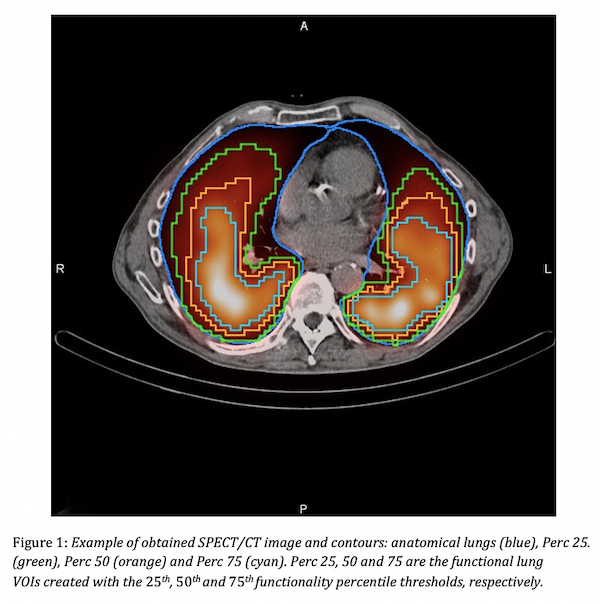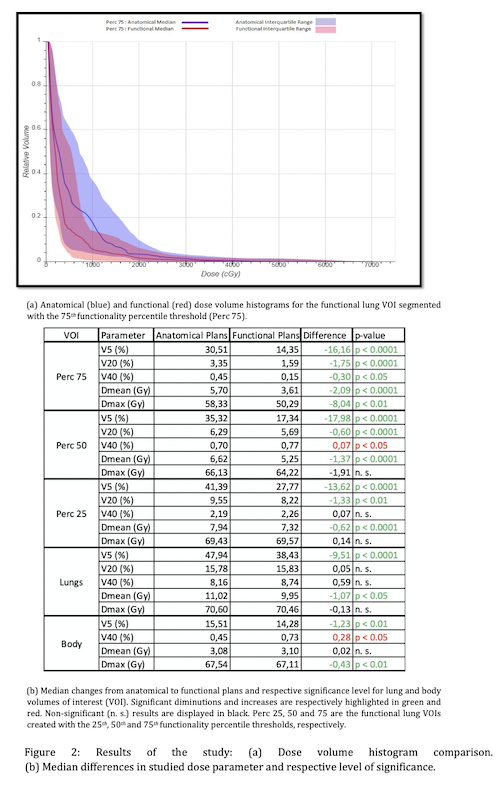Functionality-optimised radiotherapy for lung cancer patients using SPECT/CT
PH-0218
Abstract
Functionality-optimised radiotherapy for lung cancer patients using SPECT/CT
Authors: Aurélian Quinet1, Younes Jourani1, Bruno Vanderlinden1, Patricia Fernandes1, Zelda Paquier1, Florian Charlier2, Luigi Moretti2, Patrick Flamen3, Paul Van Houtte2, Dirk Van Gestel2, Nick Reynaert1
1Institut Jules Bordet - Université Libre de Bruxelles, Medical Physics Department, Brussels, Belgium; 2Institut Jules Bordet - Université Libre de Bruxelles, Radiation Oncology Department, Brussels, Belgium; 3Institut Jules Bordet - Université Libre de Bruxelles, Nuclear Medicine Department, Brussels, Belgium
Show Affiliations
Hide Affiliations
Purpose or Objective
Radiation-induced lung injury is directly related to the dose delivered to well-perfused lungs and is a common treatment-limiting toxicity of radiotherapy in lung cancer. The purpose of this in-silico study is to prospectively investigate the feasibility of SPECT-based functional optimisation in treatment planning for thoracic tumours and to evaluate possible dose improvements.
Material and Methods
Twenty-nine patients (36 cases) who underwent a lung perfusion scan on a Symbia T (Siemens Healthcare, Erlangen, Germany) prior to thoracic radiotherapy between January 2016 and September 2020 were included in the study. SPECT images without attenuation correction were used to define functional lung Volumes Of Interest (VOI), segmented with thresholds at the 25th, 50th and 75th functionality percentiles (Perc 25, Perc 50 and Perc 75, respectively) using MIM Maestro (v7.0.3, MIM Software Inc., Cleveland, USA). The contours were then rigidly registered and copied to the planning CT. Two VMAT plans with a 33×2 Gy prescription were calculated using Monaco (v5.5.1, Elekta AB, Stockholm, Sweden), one exclusively optimised on anatomical volumes following our institutional standards, and another for which an ALARA dose constraint was added to the Perc 75 VOI. Statistically significant (p < 0.05) differences for mean dose, V5Gy, V20Gy, V40Gy and max dose between both plans were assessed using a Wilcoxon signed-rank test. Correlations between the PTV volume and changes in dose parameters were also investigated.
Results
An example of segmented volumes is shown in figure 1.

A comparison of anatomical and functional DVHs per patient and per VOI showed that, in most cases, a functional optimisation significantly reduces the volume of functional lung receiving low to high doses as illustrated in figure 2a. Fractions of OARs receiving low doses were decreased but highly-irradiated volumes slightly increased. Significant median reduction of mean dose, V5Gy, V20Gy, V40Gy and max dose were observed in Perc 75, with significant positive repercussions on the mean dose, V5Gy, and V20Gy in Perc 50 and Perc 25 as well. The only statistically significant drawbacks were the median increase of V40Gy in Perc 50 (+0.07 %) and in the body (+0.28 %), which were considered clinically acceptable trade-offs. No significant dose changes were observed in the PTV, heart and spinal cord. All the results for lung and body VOIs are summarised in figure 2b. No correlation was found between the PTV volume (11 − 1312 mL) and the modification of any dose parameter by functional planning.

Conclusion
Perfusion SPECT based functional lung sparing optimisation is feasible and leads to a statistically significant dose reduction of functional lung volumes. Using the presented methodology, prospective functional lung sparing can be safely introduced into clinical practice.